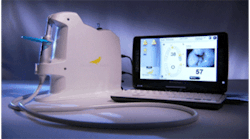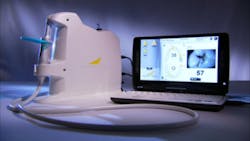Is there room for laser-based caries detection in dental hygiene practice?
Julie DiNardo, RDH, a dental hygienist in independent practice, reviews the Canary System and explains how laser-based caries detection technology can benefit both traditional and alternative practice settings.
When you hear the phrase "dental hygiene practice," you may visualize the hygiene team within a traditional dental office. What happens when laser-based caries detection technology is introduced to an independent dental hygiene practice where no dentist is present?
Product review
The Canary System (Quantum Dental Technologies) is one example of laser-based caries detection technology. It is a low-powered instrument that detects enamel breakdown and changes in the crystalline structure of tooth enamel. The practitioner and patient can discover the true health of the tooth together. The system has two scan settings: One is the "Quick Scan," which allows the practitioner to scan tooth after tooth without saving any data, and the other is the "Detailed Scan," which is used when a particular tooth is being investigated or when a report needs to be generated. When the Detailed Scan setting is selected, a photo can be taken with the intraoral camera and then be sectioned into a nine-part grid, in which each section can be scanned for the information to be saved in the Canary Cloud, an online environment where patient scan data can be viewed and managed.
Whether dental hygienists work in traditional offices or in another type of setting, such as independent practice, the Canary System supports working together. The information gathered using the Canary System can be shared easily through the Canary Cloud, so the team can focus on the care received by the patient. This information can be shared between providers, accessed by the patient, and monitored for changes over time. Reports can be provided with recommended treatments, so it is easy to give patients full disclosure. Many caries detection devices are available on the market; however, the cloud feature is unique to the Canary System.
This technology receives a positive response from patients because it is easy for patients to follow and understand. A numeric value is given to the tooth structure being scanned, and it is visible, color-coded, and audible. The numeric value appears green when a scan is in the 0–20 range, indicating a healthy tooth structure. It appears yellow when a scan is in the 21–69 range, indicating that some form of intervention might be needed. Individual treatment planning is required at this time and could include remineralizing paste, sealants, fluoride, or even a small filling. Numeric values 70–100 appear red, letting both the provider and patient know that restorative intervention is needed. Patient involvement in this information-gathering process is paramount to the success of the recommended treatment because patients are more likely to take ownership of their oral conditions once they have seen the results.
This is also a benefit of working with the Canary System in practice settings where a restorative dentist is not present, such as independent dental hygiene practices. When a patient is aware that a restoration is probably needed, he or she can be referred knowing a diagnosis is to come. Information about the patient is sent to the referring dentist, and everyone is prepared to treat that individual’s needs.
Scanning with the Canary System can be done easily in the hygiene treatment room of any office during a recall appointment. Dental hygienists can apply sealants to pits and fissures with the confidence that the enamel structure is stable prior to placement, and sealants can also be monitored for effectiveness over time. Monitoring the tooth's crystalline structure during remineralization also justifies the method of treatment and helps with the formulation of an ongoing treatment plan for the individual.
Pros
• This system allows information to be shared among providers for continued patient care.
• It offers providers the ability to generate detailed reports.
• This system has evidence-based science backing its effectiveness.
• The intraoral camera has a high-quality resolution.
• The system encourages patient involvement and understanding of recommended treatment.
• It is easy to use with excellent ongoing support.
Cons
• There is a recurring cost for plastic barrier sleeves and the laser guide.
• The initial cost is high (although this can be offset with monthly leasing options).
Final thoughts
The Canary System is definitely an investment into your practice. This technology can set you apart with advanced techniques for differential diagnosis and treatment planning. The patient-centered information gathering benefits everyone, as transparency is evident with the visual and audible reinforcements to the numerical values. This method of caries detection can enhance all practice environments: The independent dental hygiene practitioner—or the dentist and dental hygiene team within a traditional practice—can easily use this piece of technology quickly and efficiently to deliver evidence-based treatment planning.
Time to put down the pointed explorer and leave the enamel matrix intact. Detect decay at its earliest onset and intervene. Know where and when the drill is needed and develop a trusting relationship with your patients as they see you practicing dentistry in this modern age.
Editor's Note: This article first appeared in Pearls for Your Practice: The Product Navigator.Click here to subscribe. Click here to submit a products article for consideration.


